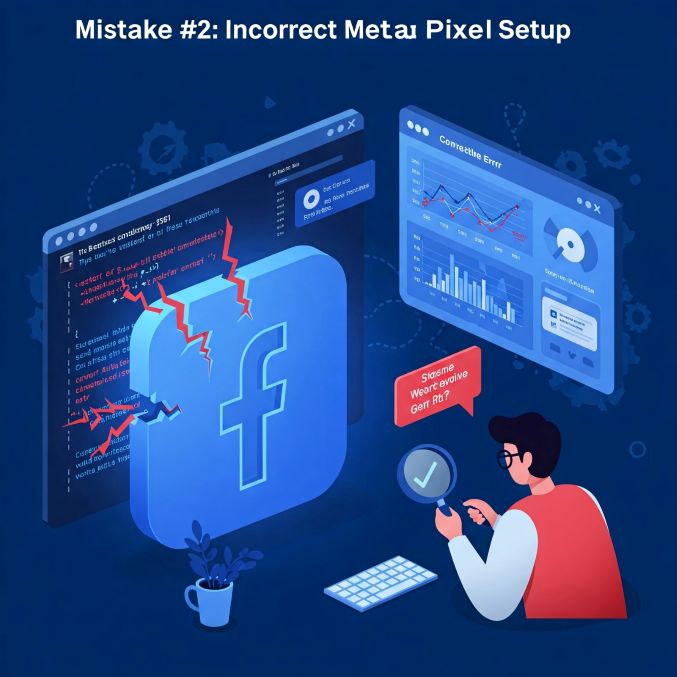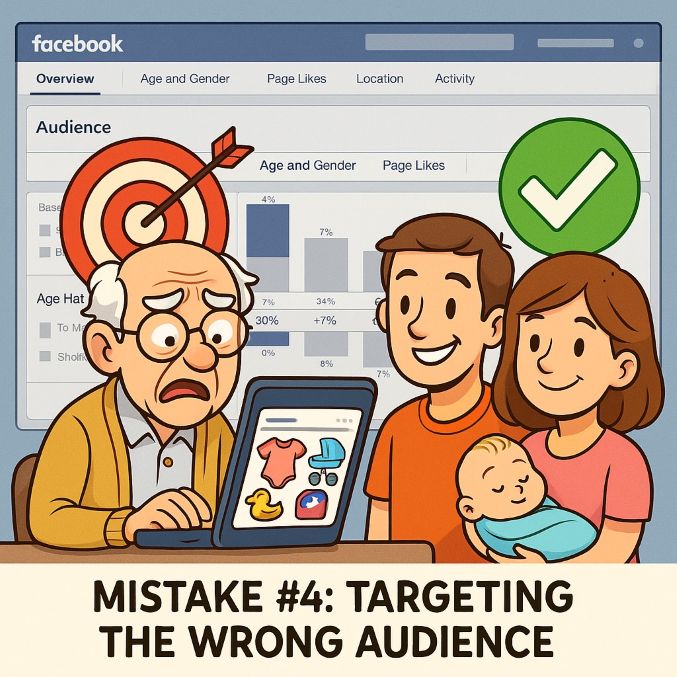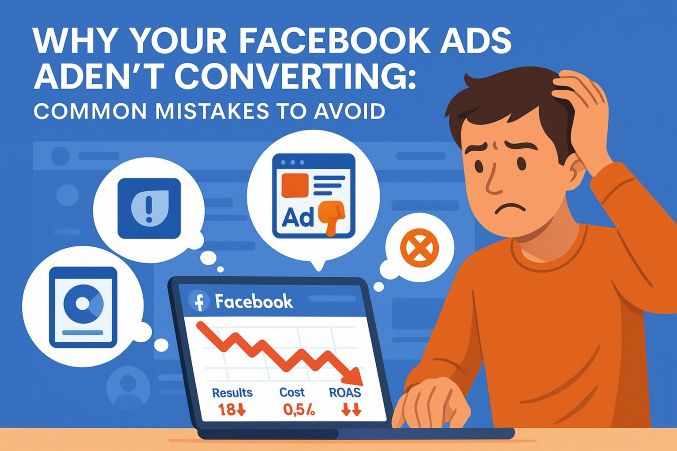Why Your Facebook Ads Aren't Converting: Common Mistakes to Avoid
Facebook Ads are a potent engine for driving traffic, creating leads, and generating sales—if applied correctly. Too many marketers deal with underperformance campaigns, hemorrhaging budget with little to no significant returns to show for it.
If your Facebook Ads are not converting, you may be guilty of a few common (but correctible) errors. In this manual, we're going to run through the initial five key errors and how you can avoid making them.
1. Unoptimized Landing Pages
The Problem:
Your ad can be brilliant, but if the user is taken to an unoptimized or off-topic page, they'll bounce without converting. When there's a misalignment between your ad and landing page, visitors get confused and kill your conversion rate.
How to Fix It:
- Align Messaging: Your landing page should reflect the promise of your ad. If your ad offers a discount, your landing page must emphasize that offer upfront.
- Mobile Optimization: Over 90% of Facebook users access the platform via mobile. If your landing page isn’t mobile-friendly, you’re losing conversions.
- Fast Load Times: Slow pages increase bounce rates. Use tools like Google PageSpeed Insights to optimize performance.
- Clear CTA: A strong, visible call-to-action (e.g., "Buy Now" or "Sign Up") guides users toward conversion.
Pro Tip: Use A/B testing to compare different landing page versions and identify what works best.

2. Incorrect Meta Pixel Setup
The Problem:
Meta Pixel (previously Facebook Pixel) monitors user action, enabling you to gauge advert performance and remarket website visitors. If installed incorrectly, you're in the dark—blind to essential conversions, click rates, and audience data.
How to Fix It:
- Check Installation: Run Facebook's Pixel Helper Chrome addon to determine if the pixel fires properly.
- Track Key Events: Set up standard events (e.g., "Purchase," "Lead," "Add to Cart") to monitor conversions.
- Test Before Launching: Run test conversions to ensure the pixel records data accurately.
Pro Tip: If you’re using Shopify or WordPress, use built-in integrations to simplify pixel setup.
3. Weak or Unclear Ad Copy
The Problem:
Ambiguous, generic, or overly sales-y ad copy doesn't capture attention. If users don't get your offer or why they should care, they'll scroll on.
How to Fix It:
- Strong Headlines: Write benefit-driven headlines such as "Get 50% Off Today Only!" rather than "Check Out Our Sale."
- Clear Value Proposition: Tell them what's in it for the user—savings, exclusivity, addressing a pain point.
- Strong CTA: Lead users with action-driven words like "Shop Now," "Claim Your Free Trial," or "Download the Guide."
Example of Effective Ad Copy:
*"Struggling with saggy skin? Our firming cream delivers visible results in 7 days—or your money back! Try it risk-free today."*

4. Targeting the Wrong Audience
The Problem:
Even the greatest ad will fail if displayed to the wrong audience. Broad or unrelated targeting results in wasted budget and poor conversion.
How to Improve It:
- Apply Detailed Targeting: Take advantage of Facebook's interest-based and behavior-based targeting capabilities.
- Develop Lookalike Audiences: Target users that are similar to your current buyers for greater conversion potential.
- Exclude Past Converters: Don't display ads to individuals who have already converted (unless upselling).
Pro Tip: Pilot various audience segments with limited budgets before scaling the top performers.
5. Ad Fatigue Among Audience
The Problem:
Repeatedly showing the same ad frustrates users, resulting in decreased engagement and increased costs. If your frequency (avg. times an ad is displayed to a user) is over 3-5, it's time to update.
How to Fix It:
- Rotate Creatives: Change images, videos, and ad copy every 1-2 weeks.
- Utilize Dynamic Ads: Serve various products based on user action automatically.
- Suspend Overplayed Ads: Once an ad's CTR becomes low, suspend it and offer a new variation.
Pro Tip: Keep track of frequency within Ads Manager—if it's higher than optimal, modify targeting or creatives.
6. Missed Campaign Goals
The Problem:
Selecting the incorrect campaign objective confuses Facebook's algorithm, and its ad delivery won't be efficient. For instance, if you choose "Traffic" but prefer "Conversions," you will receive clicks—yet not possibly sales.
How to Fix It:
- Match Objective to Goal:
- Conversions → Sales, sign-ups
- Traffic → Blog visits, page views
- Engagement → Likes, comments, shares
- Lead Generation → Email captures
- Use "Conversions" for Direct Sales: This instructs Facebook to optimize for purchases, not clicks.
- Avoid "Brand Awareness" for Direct Response: It's wonderful for reach but not for direct conversions.
Pro Tip: If testing new audiences, begin with "Traffic" or "Engagement" to warm them up before shifting to "Conversions."
7. Inadequate Budget Allocation
The Issue:
A small daily budget (5−5−10) might not provide Facebook with sufficient data to optimize. The algorithm must have at least 50 conversions weekly to learn properly—otherwise, your ads perform poorly.
How to Solve It:
- Increase Budget Gradually: Begin with at least 20−20−50/day for conversion campaigns.
- Focus on One Winning Ad: Rather than dividing 10across5ads,put10across5ads,put50 behind the winning performer.
- Use Campaign Budget Optimization (CBO): Let Facebook allocate budget to the high-performing ad sets.
Pro Tip: When scaling, raise budgets by 20-30% every few days so as not to re-trigger the "learning phase."
8. Shutting Ads Down Prematurely
The Problem:
Lots of advertisers are shutting down campaigns too early. Facebook's algorithm takes 3-7 days (occasionally longer) to optimize—cutting off ads early means never getting to experience its full capacity.
How to Fix It:
- Let the Learning Phase Complete: Check Ads Manager for "Learning" status. Edit during this time.
- Keep It Running for 7 Days: Unless performance is catastrophic (e.g., 0conversionsafter0conversionsafter100 spend), leave it alone.
- Avoid Frequent Tweaks: Frequent changes to audiences, creatives, or bids restarts learning mode.
Tip: If performance suffers after learning mode, replicate the ad set and begin re-optimization.

9. Not A/B Testing
The Issue:
Having a single ad version is not testing—guessing what works. Without A/B testing, you might be missing more successful higher-converting creatives, audiences, or CTAs.
How to Fix It:
- Test One Variable at a Time:
- Ad Creative (Image vs. Video)
- Headlines ("50% Off" vs. "Limited-Time Deal")
- Audiences (Interest-based vs. Lookalike)
- Use Facebook's A/B Testing Tool: Create experiments under "Experiments" in Ads Manager.
- Run Tests for at Least 3-5 Days: Wait for statistical significance before making a decision.
Pro Tip: The "Dynamic Creative" feature automatically tests several combinations for you.
10. Inadequate Use of Social Proof
The Problem:
Customers trust fellow customers more than they trust brands. Without reviews, testimonials, or user-generated content (UGC), conversions decline.
How to Fix It:
- Insert Customer Reviews in Ads:
- *"Rated 4.9/5 by 2,000+ customers!"*
- *"See why 10,000+ people love our product!"*
- Include UGC in Creatives: Show actual customers using your product (with consent).
- Harness FOMO:
- *"Join 50,000+ happy subscribers!"*
- "Last chance—90% sold out!"
Pro Tip: Run a UGC contest (e.g., "Tag us for a chance to win!") to collect authentic content.
11. Ignoring Mobile Optimization
The Problem:
Over 98% of Facebook users access the platform via mobile, yet many advertisers still design ads (and landing pages) primarily for desktop. If your experience isn’t seamless on phones, you’re losing most of your potential customers.
How to Fix It:
- Use Vertical Videos (9:16): Native mobile videos outperform horizontal ones.
- Check Landing Page Mobile UX:
- Quick load speeds (less than 3 seconds)
- Thumb-sized buttons (no small links)
- Few pop-ups (they're so much more frustrating on mobile)
- Preview Ads on Mobile: Test how creatives appear in Facebook's mobile feed at all times before going live.
Pro Tip: Use Facebook's "Mobile-Graded" Creative Tool to ensure your ad is best practice compliant.
12. Misaligned Ad and Landing Page Messaging
The Problem:
Your ad guarantees a "Free Trial," but the landing page promotes a paid plan as the first option. This mismatch confuses people and raises bounce rates.
How to Fix It:
- Match Headlines & Offers: If your ad reads "50% Off Today," the landing page must feature that very offer above the fold.
- Use Similar Visuals: Colors, fonts, and imagery should have a consistent feel.
- Avoid “Surprise” CTAs: Don’t switch from “Download Guide” (ad) to “Book a Call” (landing page).
Example:
✅ Ad: “Get Our Free SEO Checklist!”
✅ Landing Page: “Download Your Free SEO Checklist Now” (with same design style).
13. Overlooking Audience Data Analysis
The Problem:
Many advertisers set up campaigns but never dig into who’s actually converting. Without analyzing demographics, behaviors, or peak times, you’re missing optimization opportunities.
How to Fix It:
- Check "Breakdown" Data: In Ads Manager, review performance by:
- Age/Gender
- Device (iOS vs. Android)
- Location (cities/states)
- Pause Underperformers: If women aged over 45 convert 3X higher than men under 25, tweak targeting.
- Retarget Engaged Users: Build custom audiences from:
- Video viewers (50%+ watched)
- Cart abandoners
- Past buyers (for upsells)
Pro Tip: Utilize Facebook's "Audience Insights" tool to uncover hidden trends.
14. Choosing the Wrong Ad Type
The Problem:
To use a carousel ad when a video ad would be more effective (or vice versa) is to waste budget. Each format is best for different objectives:
|
Ad Type |
Best For |
|
Image Ads |
Easy offers, fast messaging |
|
Video Ads |
Storytelling, product demos |
|
Carousel Ads |
Multiple products/features |
|
Collection Ads |
Mobile shoppers (instant storefront) |
|
Lead Ads |
Email captures (no landing page) |
How to Fix It:
- Test 2-3 Formats: Test video vs. carousel for the same product.
- Match Format to Funnel Stage:
- Top of Funnel: Video/awareness ads
- Middle of Funnel: Carousel/catalog ads
- Bottom of Funnel: Instant Experience or Collection ads
15. Not Utilizing Retargeting Strategies
The Problem:
Only 2% of first-time visitors convert. If you’re not retargeting, you’re ignoring 98% of potential buyers who showed interest but didn’t act.
How to Fix It:
- Set Up Retargeting Audiences: Target:
- Website visitors (last 30 days)
- Engaged social media users (liked/commented)
- Email subscribers who didn’t buy
- Use Sequential Retargeting:
- Ad 1: “You left something in your cart!”
- Ad 2: "Last chance—10% off if you complete checkout!"
- Exclude Past Buyers: Unless you're upselling, don't pester repeat customers.
Pro Tip: Pair retargeting with lookalike audiences to discover new high-intent users.
16. Ignoring Video Content
The Problem:
Facebook's algorithm favors video content, but most advertisers still use static images only. Videos drive 1200% more shares than text and images together, but bad video strategy wastes spend.
How to Fix It:
- Hook audience in 3 seconds: Begin with strong text or shocking imagery
- Optimize for sound-off watch: 85% watch without sound (utilize captions)
- Test varying lengths of video:
- 6-15 seconds for cold audiences
- 30-60 seconds for retargeting
- Utilize genuine UGC-style videos (more about this in Mistake #17)
Pro Tip: Include a floating CTA button that pops up while playing to increase conversions.
17. Failing to Utilize User-Generated Content (UGC)
The Problem:
Customers believe peer endorsements 10 times more than branded content, but most ads contain slick corporate speak that doesn't resonate.
How to Fix It:
- Launch UGC campaigns: Ask customers to share experiences with branded hashtags
- Repurpose real content:
- Customer testimonials (video/text)
- Unboxing videos
- Before/after results
- Show real people: Employees using products > stock photos
- Make UGC-style ads: Imitate organic social posts instead of "ad-like" creatives
Case Study: Beardbrand boosted conversions 217% by making the jump from product shots to customer UGC.

18. Not Monitoring and Tweaking Campaigns Regularly
The Problem:
The "set it and forget it" strategy murders Facebook ad performance. What was successful last month might be useless today.
How to Fix It:
- Daily checks (5 minutes):
- Check frequency scores (optimal: 1-3)
- Check for ad fatigue (CTR decline)
- Check CPM spikes
- Weekly optimizations:
- Pause losing ad sets (less than 2% CTR)
- Scale winners (budget boost 20-30%)
- Refresh creatives (every 7-14 days)
- Monthly audits:
- Review audience breakdowns
- Test new formats/placements
- Update retargeting lists
Pro Tip: Automate rules to stop ads when KPIs fall below thresholds.
19. Overcomplicating the Message
The Problem:
Attempting to convey too many benefits in one ad makes viewers confused and water down your value proposition.
How to Fix It:
- Prioritize one core benefit per ad
- Apply the "3-30-3" rule:
- 3 seconds to hook
- 30 seconds to explain
- 3 words for the CTA
- Simplify visuals: Single point of focus > complicated compositions
- Shorten copy: Mobile user scans - goal is under 125 characters
Example:
❌ "Our app assists in productivity, time management, teamwork."
✅ "Get back 2 hours a day (free trial)"
20. Neglecting Seasonality and Trends
The Issue:
Placing the same advertisements throughout the entire year overlooks peak buying occasions and cultural touchpoints that may 10X your performance.
How to Remediate:
- Use Facebook's Trend Reports for your niche
- Schedule seasonal campaigns 2-3 months prior
- Leverage live events (sports, holidays, pop culture)
- Tailor messaging for context:
- Summer = urgency ("Limited stock for beach season!")
- Winter = emotional ("The perfect gift for mom")
Pro Tip: Utilize Google Trends to discover emerging search queries to target.
Final Thoughts
Mastering Facebook Ads isn't about one magic trick—it's about systematically eliminating these 20 common mistakes. The advertisers seeing consistent 5-10X ROAS aren't lucky; they're just avoiding these pitfalls that most beginners face.
Your Action Step Today:
Pick just one of these 20 mistakes to fix in your current campaigns. Small, consistent optimizations compound into massive results over time.
Which mistake have you found most damaging to your ads? Let me know in the comments—I'm happy to suggest specific fixes!


Comments
No Comments To Display